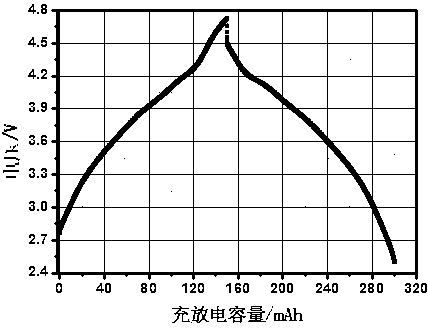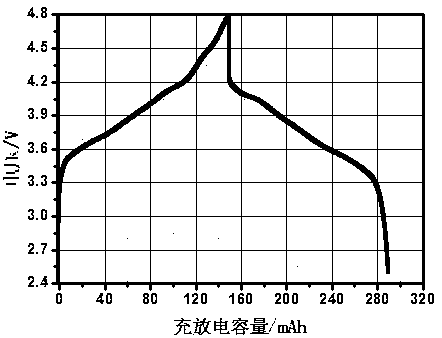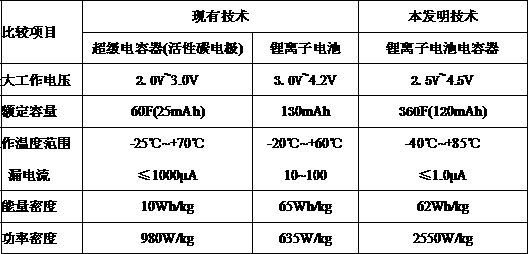Capacitor of lithium ion battery
A technology for lithium-ion batteries and capacitors, applied in electrolytic capacitors, capacitors, double-layer capacitors, etc., can solve the problems of large surface area, reduce energy density, consume large lithium ions, etc., achieve low self-discharge rate, enhance practicability, widen Effects of Using Temperature Range and Voltage Range
- Summary
- Abstract
- Description
- Claims
- Application Information
AI Technical Summary
Benefits of technology
Problems solved by technology
Method used
Image
Examples
Embodiment 1
[0022] 1520 type (diameter 15.0mm, height 20.0mm) cylindrical lithium ion battery capacitor, the negative plate of the capacitor is composed of 50% hard carbon and 50% natural graphite (capacity percentage) as active material, and then combined with carboxymethyl fiber Soluble styrene-butadiene rubber binder, and superconducting acetylene black are mixed evenly, and deionized water is used as a solvent, stirred into a slurry, and coated on a 15-micron copper foil; the positive plate is made of 95% LiMn 2 o 4 and 5% activated carbon (volume percentage) to form the active material, and then mix it evenly with conductive graphite, superconducting acetylene black and polyvinylidene fluoride binder, use N-methylpyrrolidone as a solvent, stir into a slurry, and coat It is made on 20 micron aluminum foil; the positive and negative electrodes are separated by polypropylene-polyethylene-polypropylene microporous membrane and wound to form a core. The negative ear is drawn to the posit...
Embodiment 2
[0024] 1520 type (diameter 15.0mm, height 20.0mm) cylindrical lithium ion battery capacitor, the negative plate of the capacitor is composed of 95% soft carbon and 5% modified graphite (capacity percentage) as active material, and then combined with carboxymethyl group Cellulose, soluble styrene-butadiene rubber binder, and superconducting acetylene black are mixed evenly, and deionized water is used as a solvent, stirred into a slurry, and coated on a 15-micron copper foil; the positive plate is made of 80% LiCoO 2 and LiNi 1 / 3 co 1 / 3 mn 1 / 3 o 2 The active material is composed of 20% activated carbon (volume percentage), and then mixed evenly with conductive graphite, superconducting acetylene black and polyvinylidene fluoride binder, using N-methylpyrrolidone as a solvent, stirred into a slurry, and coated It is made on 20 micron aluminum foil; the positive and negative electrodes are separated by polypropylene-polyethylene-polypropylene microporous membrane and wound to ...
Embodiment 3
[0026] 1520 (diameter 15.0mm, height 20.0mm) type cylindrical lithium ion battery capacitor, the negative plate of the capacitor is composed of 75% hard carbon and soft carbon mixed with 25% artificial graphite and natural graphite (capacity percentage) to form the active material , and then mixed with carboxymethyl cellulose, soluble styrene-butadiene rubber binder, and superconducting acetylene black, using deionized water as a solvent, stirred into a slurry, and coated on a 15-micron copper foil; The positive plate is made of 50% LiNi 0.8 co 0.2 o 2 And 50% activated carbon (volume percentage) to form the active material, then mix with conductive graphite, superconducting acetylene black and polyvinylidene fluoride binder, use N-methylpyrrolidone as solvent, stir into slurry, and coat It is made on 20 micron aluminum foil; the positive and negative electrodes are separated by polypropylene-polyethylene-polypropylene microporous membrane and wound to form a core. The nega...
PUM
| Property | Measurement | Unit |
|---|---|---|
| Diameter | aaaaa | aaaaa |
| Height | aaaaa | aaaaa |
Abstract
Description
Claims
Application Information
 Login to View More
Login to View More - R&D
- Intellectual Property
- Life Sciences
- Materials
- Tech Scout
- Unparalleled Data Quality
- Higher Quality Content
- 60% Fewer Hallucinations
Browse by: Latest US Patents, China's latest patents, Technical Efficacy Thesaurus, Application Domain, Technology Topic, Popular Technical Reports.
© 2025 PatSnap. All rights reserved.Legal|Privacy policy|Modern Slavery Act Transparency Statement|Sitemap|About US| Contact US: help@patsnap.com



